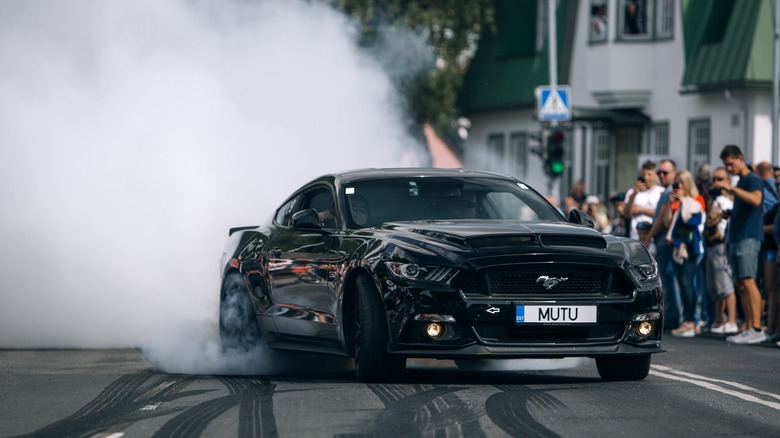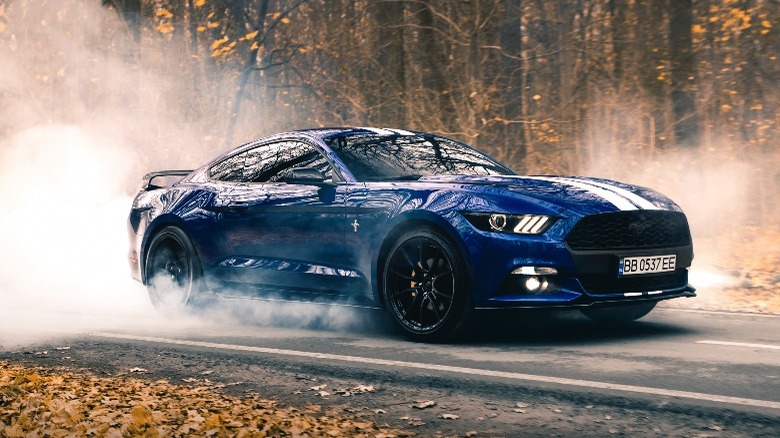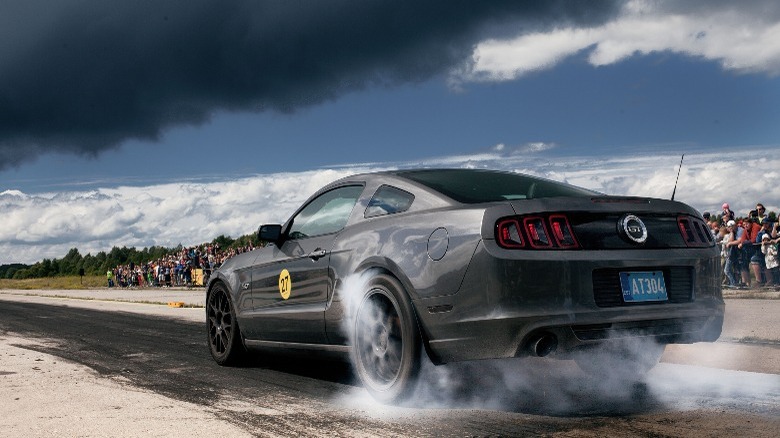Why Do Ford Mustangs Seem To Spin Out So Frequently?
When talking about iconic vehicles, it's difficult to exclude the Ford Mustang from the conversation. As one of the best-selling sports cars in the world, this American pony revolutionized the automotive industry ever since its debut in the '60s. Throughout generations, the Mustang has always turned heads for featuring some of the mightiest American V8 engines. However, engine output is not the only aspect in which the Mustang has a reputation.
Especially in the last two decades, many have raised eyebrows at the Mustang's handling. There is no shortage of videos on the internet poking fun at Mustang drivers for having trouble keeping their cars in a straight line. Mustangs frequently hitting curbs and running into the crowd at car meetings have resulted in generally negative feedback from many car enthusiasts.
The Mustang's reputation as a dangerous vehicle is more than just a claim coming from the car community. Per IIHS's data, Mustangs are among the deadliest vehicles on the road, which is why they can be likely to kill the driver in a crash. But where does such a bad reputation come from? Is there an intrinsic problem with Mustangs in general? Or is the driver to blame?
There are multiple factors contributing to the Ford Mustang's reputation as a sports car with dangerous handling. Sure, the driver's experience can certainly play a major role in the Mustang spinning out. However, there are other issues that imply the Mustang is not a tame horse. Without further ado, let's explore the main reasons behind the Mustang's notorious handling.
First, Mustangs can be too powerful for their own good
Higher-end Mustangs pack a lot of horsepower. The legendary Coyote V8 engine that Ford mounts under the Mustang GT's hood packs 486 HP. Either through an automatic or manual transmission, all of that power output goes to the car's rear wheels.
Being a rear-wheel drive muscle car is an inseparable part of the Mustang formula. While it has its own perks, the extensive history of such a formula doesn't mean it is foolproof. While certainly more fun, RWD cars, by nature, are trickier to drive than cars with an AWD or FWD drivetrain.
However, not all sporty rear-wheel drive cars have a reputation for spinning out. That gets us to the next reason contributing to the Mustang's notorious handling: the driver. The Mustang GT is one of the most affordable performance cars, with almost 500 horsepower. According to Donut Media, the Mustang GT ranks among cars with the highest dollar-to-horsepower ratio in the automotive world.
Because of this, many young and inexperienced drivers opt for the Mustang as their first entry into the sports car league. Having all that power sent to the rear wheels with little to no experience in driving performance-oriented cars can be a recipe for disaster, and some Mustang drivers seem to be prime examples of that.
Most older Ford Mustangs feature solid rear axles
The mismatch between the car's power output and the driver's experience is not the only reason you see a lot of videos and memes making fun of Mustangs. Another significant contributing factor is the solid rear axle featured in most Mustangs from 2014 and older.
Also known as the beam axle, the solid rear axle is an old design. The first generation of the Mustang featured a beam axle. For better traction, stability, and improved handling, most performance-oriented cars use independent rear axles.
However, that doesn't mean solid rear axles are entirely inferior compared to independent rear axles. Apart from the differential, the axles for the left and right wheels are pretty much connected in a solid configuration. Solid rear axles are excellent for sending lots of horsepower to the rear wheels on a straight line, making it an excellent option for drag racing on the track. Moreover, since they're more straightforward in design, it is easier to modify them.
On the other hand, solid axles tend to underperform in tight corners. Since both left and right axles are connected, the effect of any bump and pothole on the road that upsets one side of the car will be transferred to the other. Also, beam axles can cause more body rolls. Since each side of the rear suspension cannot move independently on each side, these issues result in loss of traction and ultimately make the car spin out when flooring the gas pedal.
Newer Mustangs have swapped the old solid-axle design for independent rear axles. In our recent test drive in the 2024 Mustang GT, it proved to keep its wild nature while providing more balance for the driver. Hopefully, that means new-gen Mustangs won't run into crowds after cars and coffee meetings.


